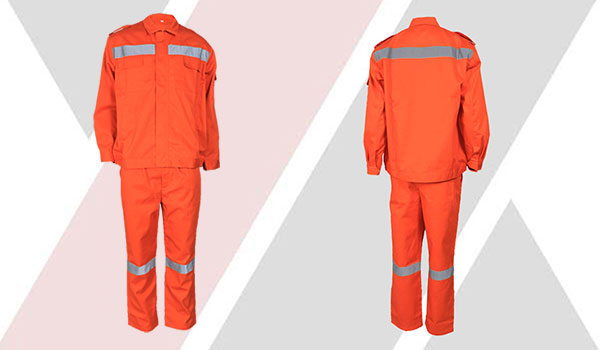


With the changes of urban structure, the high-rise and deep buildings, the development of large-scale and highly intelligence society, and the emergence of amazing technological innovation, the causes of fire once presented a complex and diversified trend. In this complex situation, the performance requirements of the new flame retardant work wear that meets the requirements of The Times are mainly embodied in the following aspects:
The outer layer has the property of permanent flame retardant
The outer layer of protective clothing is a layer directly in contact with fire and heat, which is also the most critical layer related to product performance. Currently, there are two ways to process the outer fabric of flame retardant work wear:
(1) add chemical additives to the fiber or conduct flame retardant treatment on the fabric, that is, use adsorption deposition, chemical bond bonding, non-polar van der Waals force binding or bonding to make the flame retardant stick on the fabric or yarn to obtain the flame retardant effect. The development of this method depends on the development of flame retardant and the improvement of technological process.
(2) improve the thermal stability of the fiber polymer, improve the cracking temperature, inhibit the generation of combustible gas, increase the degree of carbonization, and make the fiber not easy to ignite and burn. This approach is associated with the development of some high-performance fibers.
Good water resistance
Generally, water is used in large quantities in fire field as extinguishing agent to fight fire, so the flame retardant work wear should also have good waterproof performance. If the protective clothing, such as fire protection clothing, is not waterproof, many adverse effects will be generated. (2) the hot steam generated when the drenched firefighting suit approaches the flame will cause burns to the firefighter; (3) excessive water absorption will increase the load, affect the flexibility and comfort, so the fire clothing must have a certain waterproof performance.
Good insulation
According to the data show that the temperature of the fire between 60 ℃, 1100 ℃, and the radiant heat in 1.5 Kw / ㎡, s - 200 Kw / ㎡, s, so to adapt to the fire protective clothing must have good thermal protection performance, including the heat transfer performance of direct calcination and the radiant heat penetration performance. It is not enough to have a thin flame retardant outer layer, which would be too expensive to achieve by increasing the thickness of the outer material. The new flame retardant work wear generally adopts the permanent flame retardant staple fiber with better performance to make the thin blanket type non-woven fabric. This kind of material plays an outstanding role in the thermal protection performance of the heat insulation material.

Antistatic property
In the working environment of petroleum and chemical industry, static electricity may also be the source of ignition, causing fire. Anti-static fiber can increase the safety factor of the wearer in the flammable and explosive environment. Meanwhile, anti-static fiber can also improve the comfort and wear resistance of clothing. For example, the carbon core fiber of dupont's p-140, which eliminates static electricity, can attract the charge on the fabric. When the induction charge reaches a certain level, it will ionize the surrounding air molecules and neutralize the charge on the fabric and carbon core fiber, thus eliminating static electricity.
Comfort requirement for flame retardant work wear
In addition to meeting the most basic functional requirements, flame retardant work wear must also meet the comfort of its wearing. Fabric weight, fabric type, clothing style, material of coat and underwear and number of layers are often the main factors affecting the comfort of protective clothing. The following analysis is made from two aspects of air permeability and clothing structure:
Good air permeability
Fire field high temperature, high heat, large amount of fireman activity, human body sweating, if protective clothing poor permeability, people will feel muggy, suffocation, serious impact on combat effectiveness. At present, the solution to this problem is to adopt the flame retardant fabric of composite microporous tetrafluoroethylene film. Microporous tetrafluoroethylene film itself is resistant to high temperature. As long as the micropore diameter is within a certain range and the hydrostatic pressure and air permeability of the material reach a certain index, it can block the passage of water and unblocked the discharge of sweat steam.
Coordination of the whole structure
Flame retardant work wear should not only have good thermal protection performance, but also require light weight, easy to wear and unload, loose structure, no restrictions on the movement such as running, jumping, climbing, not easy to be hooked, comfortable to wear. Therefore, stronger measures can be taken on the structure in the parts under great stress and the parts that are easy to be injured, such as the knee, elbow, crotch, chest, shoulder, etc., in order to achieve the functionality and comfort of the clothing structure. For example, the shoulder is seamless, and the sleeve bottom is specially designed to allow the arm to reach the maximum range of motion. The cuff is fitted with a ribbed cuff, and the elastic inside the pants corner is tightened and the reversible vertical collar design is used to prevent spillage of fire, etc. The fire-retardant cotton collar is safe, comfortable and sweat-absorbent. The suspenders can be adjusted; Add one more cloth to the knee of trousers, lined with flame retardant, heat insulation cotton, anti-wear and protect the knee. High brightness flame retardant reflective tape increases the visibility of the wearer.